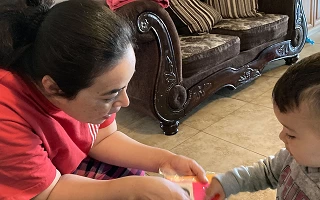Discipline can be tricky with toddlers, as they have a limited understanding, and are very impulsive beings! Try these tips when guiding your child's development.
Discipline is often viewed as a form of punishment or a solution for handling a troublesome child. Because it means to teach, discipline should not be perceived only as a way to dissuade a child from an undesirable behavior, but to teach the child the correct action or behavior for the next time they are in the same situation. Discipline can be tricky with toddlers, as they have a limited understanding, and are very impulsive beings!
Here are some tips to help.
Keep rules simple
Choose only three rules that can be easily followed such as...
- Use kind hands
- Couches are for sitting
- Food stays on the table
Positive Statements
Use positive statements when correcting a toddler’s behavior. These statements should describe the type of behavior that you desire to see...
- We use kind hands
- We share our toys
- We eat our food
Safety Issues
When there is a safety issue at hand, use “no” to reinforce the rule.
- No running near cars. We hold mom’s hand.
- No climbing on the furniture. We keep our feet on the ground.
Giving time outs
Time outs are most effective when they are consistent.
- If you use a time out, the child can sit in a chair, stand by a wall, or be placed in a playpen.
- Use the same method each time.
- One minute for the age of the child is appropriate – a 2 year old can do two minutes of time out.
It's important to choose wisely the battles you wish to pick. Toddlers are still learning about their world. They will test their boundaries - it’s a healthy part of development. As a parent, be firm and consistent on the rules you choose to enforce. On other issues that don’t matter as much, you can choose to be lenient.
Keeping routines predictable and consistent will help you avoid issues. A child who knows what to expect can align his or her behaviors more easily. When situations arise, use logical consequences. If your child doesn’t want to change from pajamas into daytime clothes, tell the child that pajamas are for sleeping and put the child in their crib until they agree to change.
Give the child chances to be good – and catch them being good. Positive praise for good behavior goes a long way in preventing the undesirable behavior. Create an environment that is conducive to being good will help. If the child’s play area is full of objects that they are not allowed to touch, they will be constantly told no as they explore and learn. Instead, move those types of objects to a different room so that the child isn’t tempted. If you have to take an object away from your child that they shouldn't play with, exchange it for something else instead of taking it away entirely.
Above all make sure that you are calm before disciplining your child. This will help to avoid yelling and teach your child healthy habits for dealing with conflict.
 Mary Cannon is a Program Manager with the Arizona Partnership for Children (AzPAC) program, Parents As Teachers. AzPAC is a partnership between Catholic Charities Community Services and Devereux Advanced Behavioral Health Arizona that provides family support through home visits, group connections, screenings and assessments, along with needed resources.
Mary Cannon is a Program Manager with the Arizona Partnership for Children (AzPAC) program, Parents As Teachers. AzPAC is a partnership between Catholic Charities Community Services and Devereux Advanced Behavioral Health Arizona that provides family support through home visits, group connections, screenings and assessments, along with needed resources.








